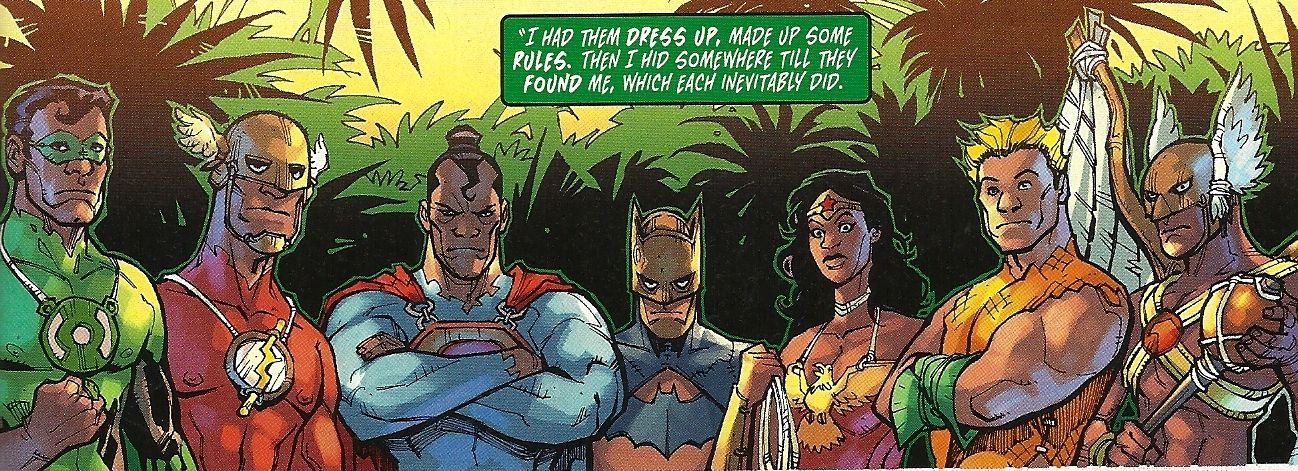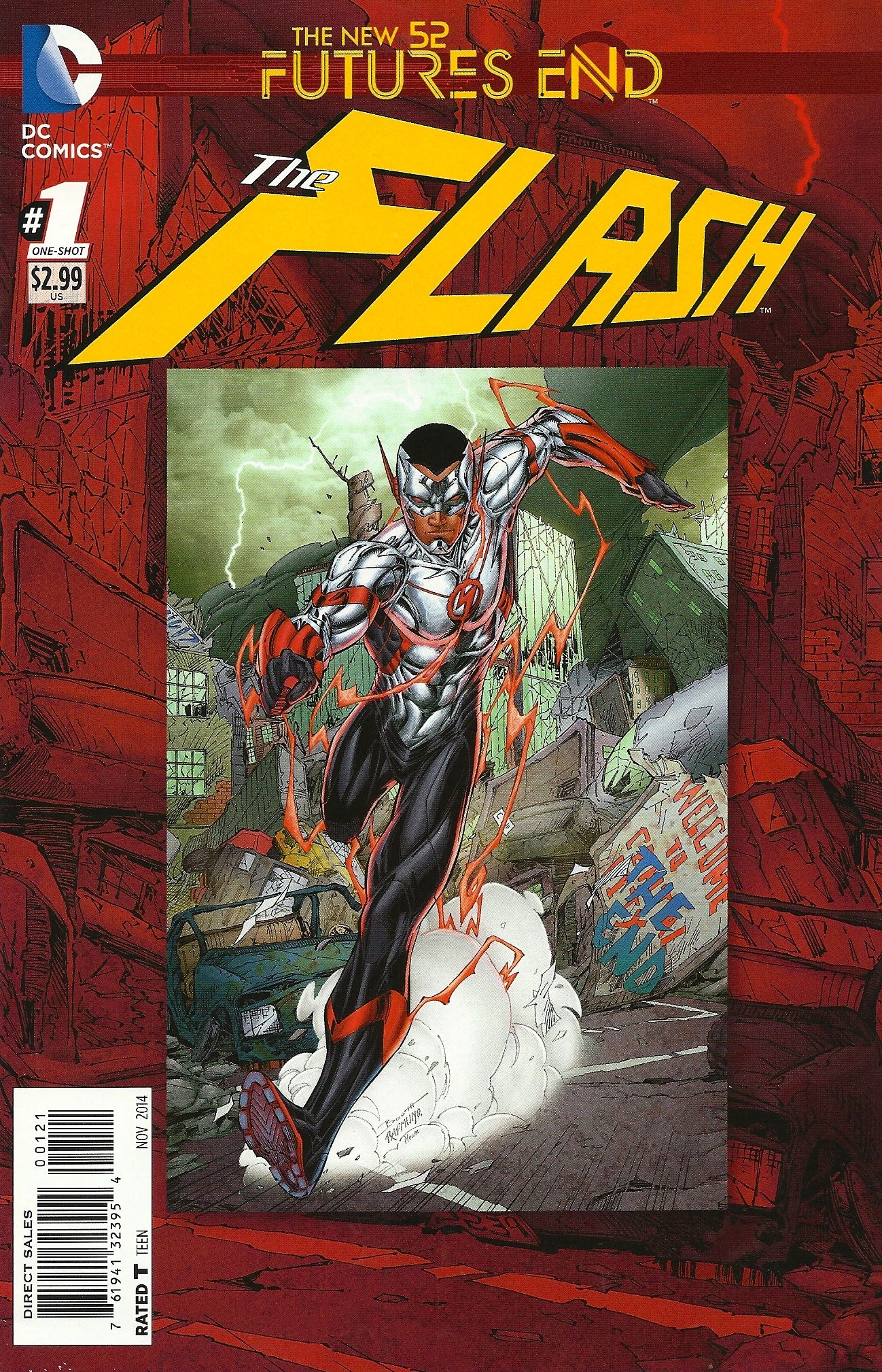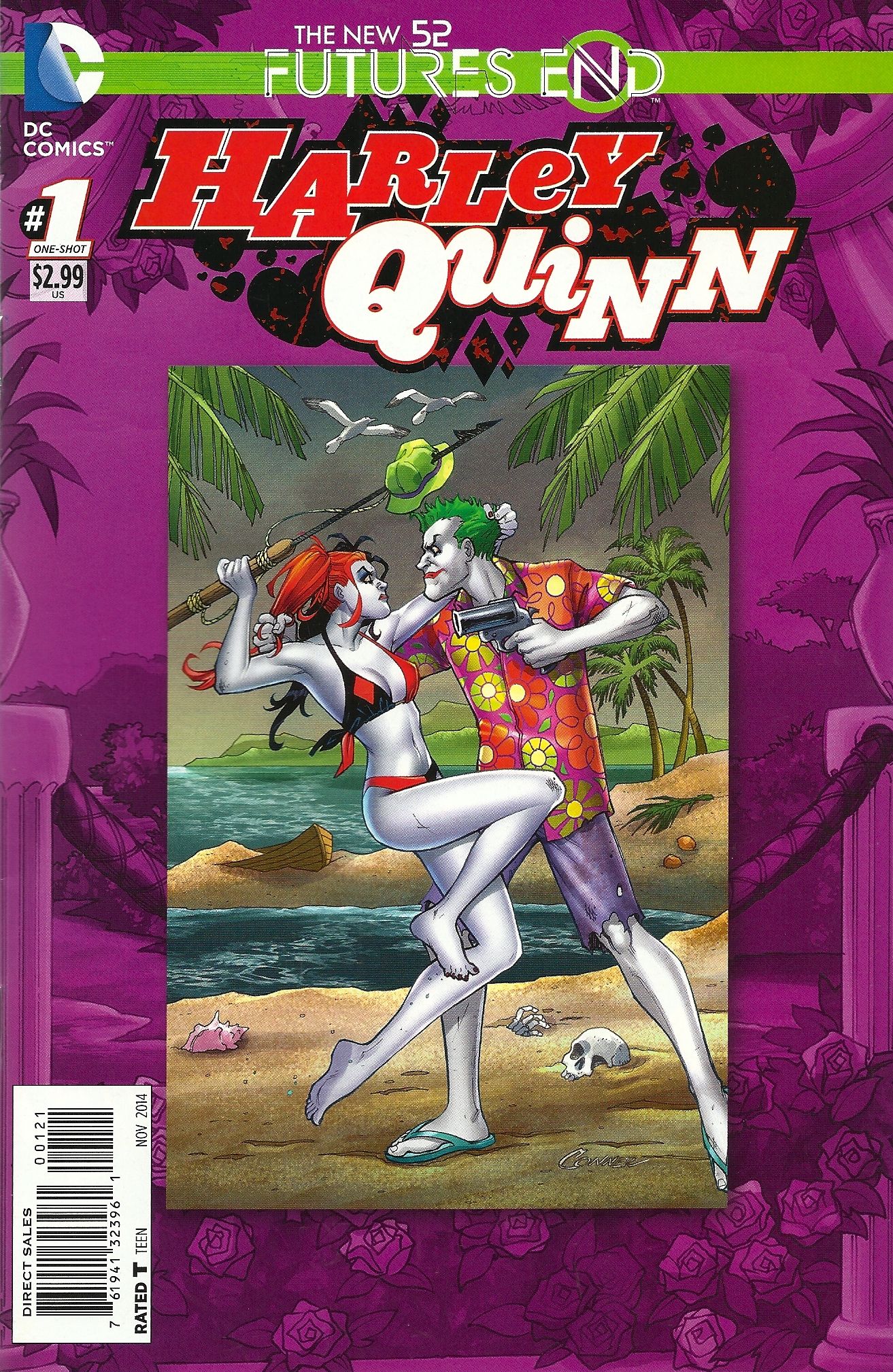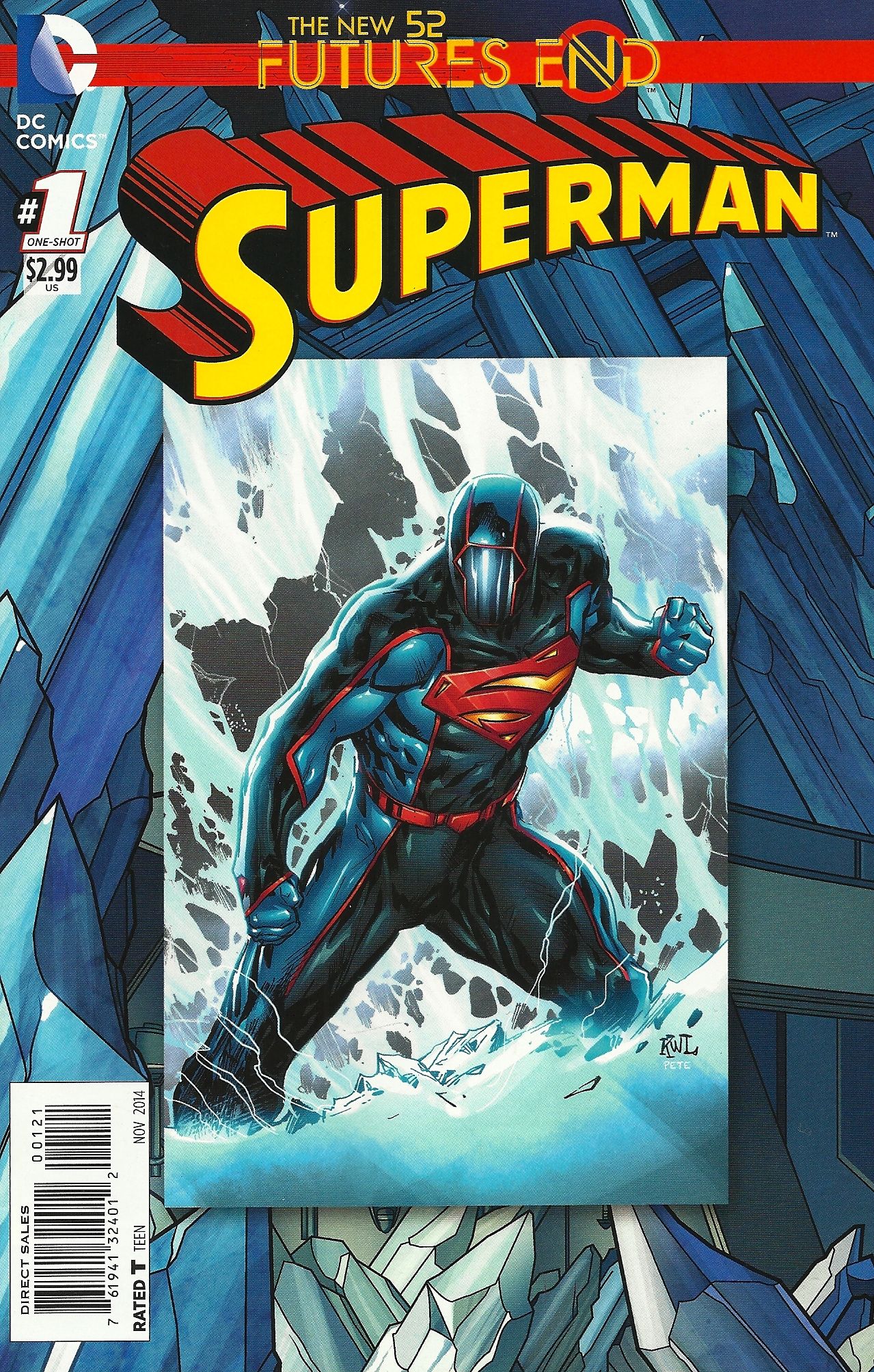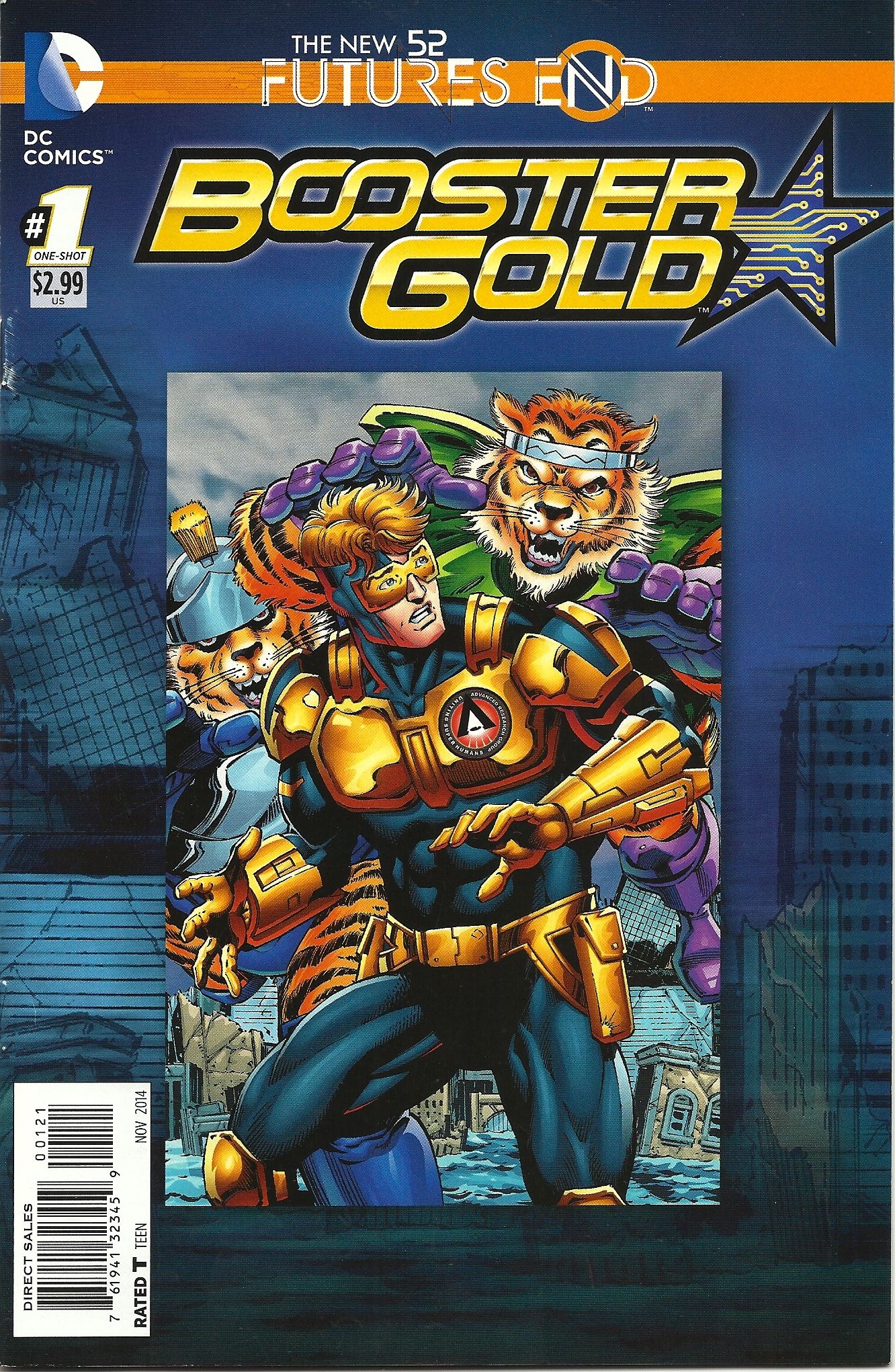In the fullness of time, all things come to an end: Futures, worlds, even month-long publishing initiatives. And so Wednesday brought with it the final batch of Futures End specials from DC Comics.
Of this week's 10 releases, I read four, and I was pleasantly surprised to find that most of those were pretty good ... and at least two of them even tied in to the events of The New 52: Futures End, the weekly series that nominally gives the one-shots a reason to exist.
Heck, one of them tied in to the series, which saw the release of its 21st issue this week, strongly and directly enough that I wouldn't be surprised if it turned up in one of the eventual trade collections of Futures End.
The Flash: Futures End #1
Written by Robert Venditti and Van Jensen, penciled by Brett Booth, inked by Norm Rapmund and colored by Andrew Dalhouse
This issue is likely one regular readers of The Flash will want to read, while those picking up Futures End as a way to check out portions of DC's New 52 line may want to skip: It reads very much like a continuation of the current Flash storyline and, despite the "Five Years From Now" setting, doesn't seem to have anything to do with the world of Futures End (in which Barry Allen is still The Flash and hasn't changed at all, not even tweaking his awful, line-riddled costume).
The already-in-progress Flash storyline features a dark Flash from the future traveling back through time to the present. This Flash, an older Barry Allen who wears a black costume with electrical blue highlights, is visiting the present in order to correct some of the mistakes he's made, mostly pertaining to not slaughtering his rogues gallery one by one (here The Reverse Flash gets an adjustment from the Man of Steel School of Chiropracty).
In this issue, that future version of Barry meets another future version of Barry (the Five Years From Now version of Futures End), on his his way back to the present, where he'll encounter the current version of Barry Allen, who — see, this is why I hate time-travel comics.
Anyway, it's one version of a possible-future Flash Barry Allen versus another version of a possible-future Flash Barry Allen for the fates of New 52 Iris West and New 52 Wally West. Dramatic things happen, including Wally getting Speed Force powers and one of those future Flashes getting pretty messed up, but because this is simply a possible alternate future, the real conclusion will occur in a future issue of The Flash. Set in the past ... by which I mean the present.
As for the cover, in which we see the new, New 52 version of the The Flash Wally West, wearing the worst imaginable Flash costume and looking like he's about to twist the hell out of his left ankle, that Flash only appears in a single panel, previewing the next issue of Flash.
Harley Quinn: Futures End #1
Written by Jimmy Palmiotti and Amanda Conner, drawn by Chad Hardin and colored by Alex Sinclair
Like The Flash issue, this has absolutely nothing to do with Futures End, so is geared less toward Futures End readers than Harley Quinn readers. (We've already seen a Futures End Harley in Suicide Squad: Futures End #1, and this Harley bears no resemblance to that one. Also, The Joker has played a so-far very small role in Futures End, in the 35 Years From Now nightmare future.)
Unlike The Flash issue, this stands alone perfectly well as a decent done-in-one comic with a beginning, middle and end: If you've been looking to sample the surprisingly successful new volume of Harley Quinn, this is actually a pretty good example of the book, and, as it's set in a possible future, there is almost no continuity to worry about (members of Harley's supporting cast appear in only the first panel ... unless you count Bernie, the taxidermied beaver she talks to, not that he has an tricky backstory or anything).
Five years from now, Harley winds up shipwrecked on a small uncharted island, where she struggles to survive for a few pages before life gets much easier -- when she encounters a tribe that worships The Joker as its god-king ... along with The Joker himself (his face sewn back on; Hardin actually does a rather nice job of showing the stitches from certain angles in subtle acknowledgment of his New 52 history).
Survival of course gets much, much harder again soon, as Harley's relationship with The Joker has always been ... dramatic, and this particular tribe would like its pale, clown-like deities to have a word with the about-to-explode volcano. Face to face, preferably.
The only connection to Futuers End is in the costuming of a superhero who appears in the final few panels, although he's still rendered immediately recognizable. It's mostly just another issue of Harley Quinn, which is either good, bad or great, depending on your feelings about the series.
I'm not a fan of Harley Quinn but, that said, I found this to be the best-written issue I've read of the series. Hardin does his usual rather incredible job, the writing team here providing him with lots of opportunities to draw cool stuff, from exotic and dangerous wildlife to natives using coconuts to cosplay as Batman and the Justice League (see above).
Superman: Futures End #1
Written by Dan Jurgens, drawn by Lee Weeks and colored by Dave McCaig
The story of Superman, and the mysterious masked Superman who has been standing in for him, has begun to unfold in the pages of Futures End, where the surprising identity of the latter has been revealed. (I should note, that costume is a bit of a cheat, as it seemed designed more to keep readers from guessing than to keep DC civilians from noticing "Superman" is not Superman; the guy under the mask looks so much like the Man of Steel he probably could have gotten away with a domino mask, or even a different haircut.)
This comic, written by Jurgens — who is, of course, one-fourth of the Futures End writing team -- features Lois Lane going to Billy Batson to learn why he gave up being Captain Marvel Shazam in favor of pretending to be Superman following the mysterious war with Apokolips and Earth-2 (finally dramatized in this week's Futures End #21), which took such a toll on the real Superman that Kal-El turned to super-farming, Kingdom Come-style.
Featuring great art by Lee Weeks and Dave McCaig, this is among the best-looking of these specials, and probably the best the world of Futures End has looked.
Jurgens' story works in standalone fashion, although probably not as well as it does in relation to Futures End, as it features some background on one of that series' bigger mysteries to date, and features a rather important turning point for the new Shazamerman.
Two classic Captain Marvel villains also show up: Black Adam, in a scene that explains how he ended up in the Phantom Zone, where we found him in Futures End; and a particularly evil version of minor villain Ibac.
Booster Gold: Futures End #1
Written by Dan Jurgens, drawn by Brett Booth,Ron Frenz, Scott Hanna, Mark Irwin, Jurgens, Steve Lightle, Moritat, Norm Rapmund and Stephen Thompson, and colored by John Kalisz
This issue is noteworthy for a couple of reasons, one of which was apparent as soon as it was announced, the other of which becomes apparent as quickly as one reads it.
First, it's the only one of this month's 40-plus Futures End specials that's not connected to a monthly, ongoing New 52 series, and it's drawn by a squadron of different artists.
Second, as the presence of some Kamandi-style tiger men may indicate, the book involves time travel and multiversal travel to some surprisingly familiar settings, and ends up looking pretty important to the grand scheme of the DCU setting moving forward. It ends with the tag, "To Be Continued Where Worlds and Futures End!" and, when coupled with the ending of this week's Superman: Doomed #2 and the in-progress Multiversity, it sure looks like the — or at least a — multiverse is returning in a big way. That of course calls into question whether the the New 52 reboot is heading for any sort of re-rebooting or de-rebooting, or just some continuity and/or costuming clean-up in the near future.
As for the comic itself, Jurgens' script is pretty old-school, with a clearly confused Booster Gold being bounced around through what he assumes is simply the time stream, narrating aloud his actions and and theories as to what might be going on — although appearances by the likes of Gotham By Gaslight's Batman and the original Charlton design of Captain Atom will clue readers in that Booster's not just moving back and forth, but also side to side. Each shift in time and/or place brings with it a different art team.
Another Booster eventually shows up, as do two Blue Beetles, and Brainiac/Brother Eye — the apparent big villain of Futures End — and while there is very little in the way of resolution, there's an awful lot of portentous teasing going on.
The art teams vary enough in styles that not every page will be to each reader's liking, but with that many talented folks involved, you can be sure to like a good chunk of the book.

